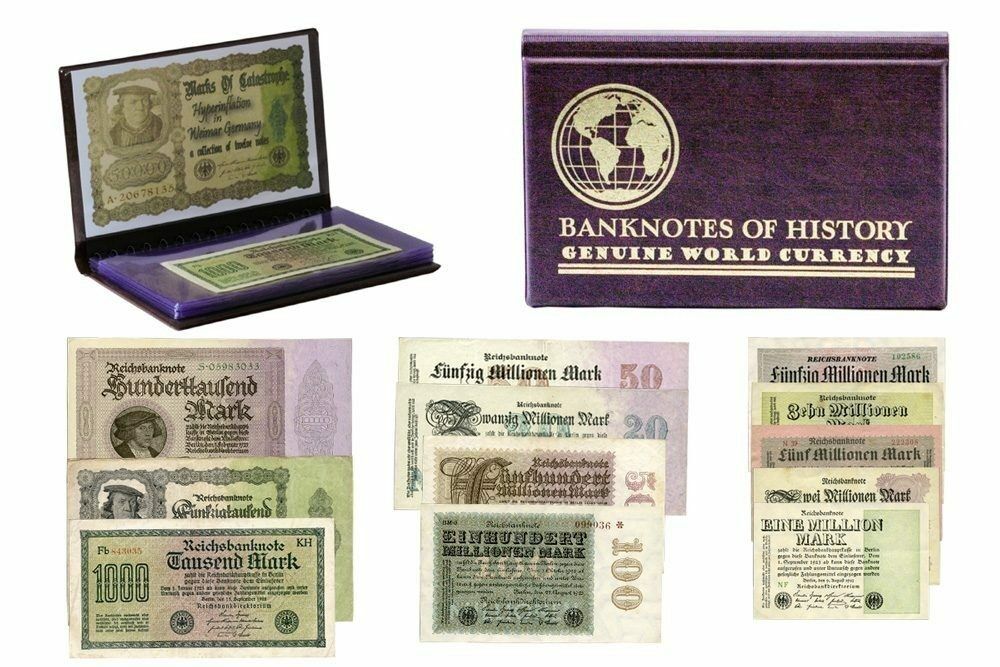German Hyperinflation Banknotes
German hyperinflation banknotes are fascinating relics of a turbulent period in history that continue to captivate collectors worldwide. These banknotes, issued during the early 1920s in Germany, bear witness to an era of unprecedented economic turmoil, where the value of money deteriorated at a staggering pace. In this article, we will delve into the intriguing world of German hyperinflation banknotes, exploring their historical context, characteristics, and why they have become highly sought-after collectible items.
Historical Context: The Weimar Republic’s Hyperinflation Crisis
The German hyperinflation of the early 1920s was a dire consequence of the economic and political instability that followed World War I and the Treaty of Versailles. The Weimar Republic, established in 1919, faced immense challenges, including war reparations, high unemployment, and a crippled industrial base. To finance these obligations, the government resorted to printing excessive amounts of money, resulting in hyperinflation.
Hyperinflation refers to a situation where a country’s currency rapidly loses its value, leading to skyrocketing prices for goods and services. In Germany, this phenomenon reached catastrophic levels, with prices doubling every few days. At its peak in November 1923, the exchange rate stood at approximately 4.2 trillion German marks to one US dollar.
Characteristics of German Hyperinflation Banknotes
German hyperinflation banknotes are distinctive in several ways, which add to their allure for collectors:
- High Denominations: These banknotes often feature astronomical denominations, such as one billion marks or even larger. These large figures serve as a stark reminder of the hyperinflation’s severity.
- Intricate Designs: Despite their massive denominations, these banknotes boast intricate and artistic designs. They often feature historic figures, allegorical motifs, and detailed engravings.
- Varied Printing: Due to the rapidly changing economic conditions, German authorities issued multiple series of banknotes within short timeframes. Each series had its unique design and anti-counterfeiting features, making collecting a diverse and challenging endeavor.
- Paper Quality: To keep up with the ever-decreasing value of the currency, the quality of paper used for these banknotes deteriorated over time. Collectors appreciate the variations in paper quality as an important aspect of these artifacts.
- Notgeld: In addition to government-issued banknotes, many German towns and cities issued their own emergency currency, known as “Notgeld,” during the hyperinflation crisis. These local notes are often colorful and creatively designed, reflecting the uniqueness of each locality.
Why Collect German Hyperinflation Banknotes?
Collecting German hyperinflation banknotes offers a unique blend of historical significance, artistic appeal, and financial intrigue. Here are some compelling reasons why collectors are drawn to these banknotes:
- Historical Significance: German hyperinflation banknotes provide a tangible connection to a critical chapter in world history. They serve as reminders of the devastating consequences of economic mismanagement and war.
- Artistic Value: The intricate designs and detailed engravings on these banknotes make them miniature works of art. Collectors appreciate the craftsmanship that went into their creation.
- Intriguing Stories: Each banknote carries its own story. Collectors often research the history and context behind these notes, uncovering tales of desperation, creativity, and resilience during a period of extreme economic hardship.
- Limited Availability: While vast quantities of these banknotes were printed during the hyperinflation crisis, their survival in good condition is relatively rare. Many were used and discarded, making well-preserved specimens highly collectible.
- Investment Potential: Some collectors view German hyperinflation banknotes as potential investments. As they become scarcer over time, their value may appreciate, offering a unique combination of historical and financial appreciation.

Factors Influencing Their Collectibility
Several factors contribute to the collectibility of German hyperinflation banknotes:
- Condition: The condition of a banknote significantly impacts its value. Collectors seek well-preserved examples with minimal wear, folds, or damage.
- Rarity: Some series or denominations are rarer than others due to limited printing or survival rates. Rare banknotes often command higher prices in the collector’s market.
- Historical Significance: Banknotes associated with specific events, figures, or locations during the hyperinflation crisis may be more sought after by collectors interested in historical connections.
- Notgeld: Notgeld notes, issued by local municipalities, offer collectors a diverse range of designs and themes. Collectors often seek to complete sets of Notgeld from specific regions.
- Authentication: Due to their collectible value, some banknotes have been counterfeited. Authentication and certification by reputable grading services add to a banknote’s desirability.
FAQs about German Hyperinflation Banknotes
Q1: Are German hyperinflation banknotes still legal tender today?
A1: No, these banknotes lost their value long ago and are no longer considered legal tender in Germany or anywhere else.
Q2: How can I determine the value of my German hyperinflation banknotes?
A2: The value of these banknotes depends on factors such as condition, rarity, and historical significance. Consulting with a numismatic expert or using reputable price guides and online auctions can help you determine their value.
Q3: Where can I buy German hyperinflation banknotes?
A3: You can find German hyperinflation banknotes at numismatic shops, coin shows, online auction platforms, and through specialized dealers.
Q4: Can I invest in German hyperinflation banknotes?
A4: While these banknotes can appreciate in value over time, it’s essential to approach collecting as a hobby rather than a guaranteed investment. Research the market and seek advice from experienced collectors or dealers.
Conclusion
German hyperinflation banknotes offer a captivating blend of historical significance, artistic value, and collectible appeal. They serve as tangible reminders of a tumultuous period in Germany’s history and continue to intrigue collectors worldwide. Whether you’re a seasoned collector or a novice, exploring these banknotes can be a rewarding journey into the past, making them truly valuable treasures in the world of numismatics.